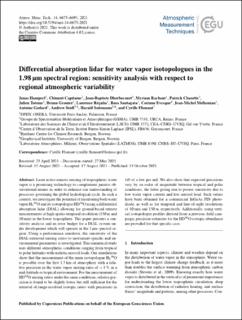| dc.contributor.author | Hamperl, Jonas | |
| dc.contributor.author | Capitaine, Clément | |
| dc.contributor.author | Dherbecourt, Jean-Baptiste | |
| dc.contributor.author | Raybaut, Myriam | |
| dc.contributor.author | Chazette, Patrick | |
| dc.contributor.author | Totems, Julien | |
| dc.contributor.author | Grouiez, Bruno | |
| dc.contributor.author | Régalia, Laurence | |
| dc.contributor.author | Santagata, Rosa | |
| dc.contributor.author | Evesque, Corinne | |
| dc.contributor.author | Melkonian, Jean-Michel | |
| dc.contributor.author | Godard, Antoine | |
| dc.contributor.author | Seidl, Andrew | |
| dc.contributor.author | Sodemann, Harald | |
| dc.contributor.author | Flamant, Cyrille | |
| dc.date.accessioned | 2022-03-29T08:46:36Z | |
| dc.date.available | 2022-03-29T08:46:36Z | |
| dc.date.created | 2021-11-08T09:30:34Z | |
| dc.date.issued | 2021 | |
| dc.identifier.issn | 1867-1381 | |
| dc.identifier.uri | https://hdl.handle.net/11250/2988204 | |
| dc.description.abstract | Laser active remote sensing of tropospheric water vapor is a promising technology to complement passive observational means in order to enhance our understanding of processes governing the global hydrological cycle. In such a context, we investigate the potential of monitoring both water vapor H216O and its isotopologue HD16O using a differential absorption lidar (DIAL) allowing for ground-based remote measurements at high spatio-temporal resolution (150 m and 10 min) in the lower troposphere. This paper presents a sensitivity analysis and an error budget for a DIAL system under development which will operate in the 2 µm spectral region. Using a performance simulator, the sensitivity of the DIAL-retrieved mixing ratios to instrument-specific and environmental parameters is investigated. This numerical study uses different atmospheric conditions ranging from tropical to polar latitudes with realistic aerosol loads. Our simulations show that the measurement of the main isotopologue H216O is possible over the first 1.5 km of atmosphere with a relative precision in the water vapor mixing ratio of <1 % in a mid-latitude or tropical environment. For the measurement of HD16O mixing ratios under the same conditions, relative precision is found to be slightly lower but still sufficient for the retrieval of range-resolved isotopic ratios with precisions in δD of a few per mil. We also show that expected precisions vary by an order of magnitude between tropical and polar conditions, the latter giving rise to poorer sensitivity due to low water vapor content and low aerosol load. Such values have been obtained for a commercial InGaAs PIN photodiode, as well as for temporal and line-of-sight resolutions of 10 min and 150 m, respectively. Additionally, using vertical isotopologue profiles derived from a previous field campaign, precision estimates for the HD16O isotopic abundance are provided for that specific case. | en_US |
| dc.language.iso | eng | en_US |
| dc.publisher | Copernicus | en_US |
| dc.rights | Navngivelse 4.0 Internasjonal | * |
| dc.rights.uri | http://creativecommons.org/licenses/by/4.0/deed.no | * |
| dc.title | Differential absorption lidar for water vapor isotopologues in the 1.98 μm spectral region: Sensitivity analysis with respect to regional atmospheric variability | en_US |
| dc.type | Journal article | en_US |
| dc.type | Peer reviewed | en_US |
| dc.description.version | publishedVersion | en_US |
| dc.rights.holder | Copyright 2021 the authors | en_US |
| cristin.ispublished | true | |
| cristin.fulltext | original | |
| cristin.qualitycode | 1 | |
| dc.identifier.doi | 10.5194/amt-14-6675-2021 | |
| dc.identifier.cristin | 1952185 | |
| dc.source.journal | Atmospheric Measurement Techniques | en_US |
| dc.source.pagenumber | 6675-6693 | en_US |
| dc.relation.project | EC/H2020/821868 | en_US |
| dc.relation.project | EC/H2020/773245 | en_US |
| dc.identifier.citation | Atmospheric Measurement Techniques. 2021, 14 (10), 6675-6693. | en_US |
| dc.source.volume | 14 | en_US |
| dc.source.issue | 10 | en_US |

